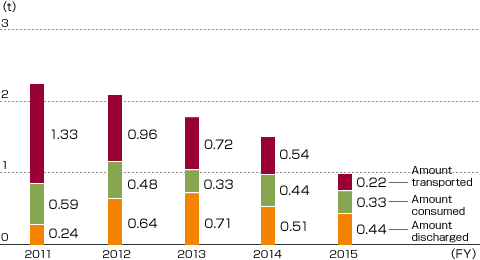 Environmental Risk and Chemical Substance Management
Environmental Risk and Chemical Substance Management

Basic Policy for Environmental Risk Management
The Advantest Group sets voluntary standards more stringent than prevailing environmental laws and regulations, and implements such standards in the course of operating equipment that could potentially impact the environment, and in monitoring and assessing those operations.
Furthermore, to ensure that we can respond without hesitation should an environment-related incident occur, we have forged rules for addressing such risks, stipulated in documented operating procedures and chemical substance emergency-response procedures and other such guidelines, and have put management systems in place related to those rules.
Moreover, our employees and contractors handling particularly high risk operations regularly take part in specialized training and emergency drills, which are conducted to ensure that they are able to act swiftly in the event of an emergency.
Business bases compliance management

Basic Policy for Chemical Substance Management
We are working to ensure safety management and compliance with laws and regulations in the use and storage of chemical substances used at Advantest Group business locations.
To this end, we have adopted a chemical substance management system. This system facilitates chemical substance registration, safety reviews, input/output control, and the calculation of data required by relevant laws and regulations, as well as making the material safety data sheets (MSDS) that are necessary for the safe handling of chemical substances available for inspection at any time.
In addition, in order to realize strengthened risk management and chemicals substance management, we are constructing a safety training system, and are conducting audits and providing guidance through the corporate chemical management division to ensure the safety of stored chemical substances, so as to further enhance our safety control system.
Furthermore, we plan to build up our global management system as we strive to achieve the same level of risk management overseas as in Japan.
Improving Chemical Substance Management: “Aiming for More Precise Management”

Strict chemical controls

Controls applied to each and every container
At Advantest Group, we manage the chemical substances that we use by container through our chemical substance management system. Depending on the chemical substances management level specified under the PRTR Law, the Poisonous and Deleterious Substances Control Law, the Occupational Safety and Health Act and other laws and regulations, we establish a classification system of management ranks and set the management method according to each rank, with the aim of having a flexible system.
Adopt the high-precision management methods in line with the different level of risk posed by different chemical substances
We implement training in chemical substance handling for Advantest Group employees, ensuring that employees understand how to handle particular types of chemical substances and are aware of the key points to note regarding their use.
Management procedures are simplified for chemical substances that are less hazardous, and autonomous management is implemented with respect to commercially-available sprays, adhesives, etc.
Chemical substance control ranks
| Rank | Conditions for application | Locked storage | Dispensary control | Inventory checks |
|---|---|---|---|---|
| 4 | Chemical substance is extremely toxic or has a profound social impact; registration with national or other government is necessary. Examples: narcotics, stimulants, etc. | Yes | Yes | As required by law |
| 3 | Chemical substance is highly toxic; any loss must be reported. Examples: poisons, deleterious substances, etc. | Yes | Yes | Monthly |
| 2 | Chemical substance is inflammable, corrosive, or poisonous with prolonged exposure. Examples: organic solvents, acids, alkalis, etc. | Yes | Yes | Twice annually |
| 1 | Chemical substance is not very harmful, but due to the large amounts used, control is necessary. Examples: solder paste, Fluorinert, etc. | No | Yes | Twice annually |
| 0 | Chemical substance is not very harmful and does not warrant special control. Examples: some adhesives, grease, lubricants, paint, lead-free solder, wire solder, bar solder, sprays (spray oil, cooling spray), etc. | No | No | No |
In line with this management approach, proper after-use treatment will be followed, such as making a request to a waste treatment company.
PRTR Data

Implementation of General and Specialist Chemical Substance e-learning Education

Materials used in training on chemical substances
We carry out general chemical substance education for employees, with the aim of making participants aware of the possibility of accidents or environmental pollution through mishandling even of everyday chemicals, and ensuring that they understand ways of reducing these risks. For employees who use chemical substances every day, we conduct a more practical specialist education every year through e-learning, from the perspective of awareness of dangers and safe handling.
In this program we explain things simply, using examples of accidents, regarding chemical substances regulated under the main laws such as poisons, deleterious substances, organic solvents, specific chemical substances, hazardous materials covered by the Fire Services Act, etc.
In fiscal 2015 we conducted general education for all new employees and specialist training for 566 employees who handle chemical substances.
<Content>
- The danger of chemical substances (effects on the human body)
- The importance of safety training for chemical handlers
- The importance of wearing personal protective equipment (gloves, goggles, masks, etc.)
- Points to be observed according to the requirements of the law
Special medical diagnosis, selection of a work leader, environmental measurement, inspection of ventilation equipment, notification of designated hazardous materials specified under the Fire Services Act, etc.
